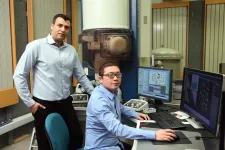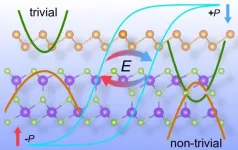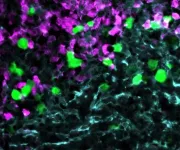(Press-News.org) North Carolina State University-led researchers have developed an analytical measurement "framework" which could allow organic solar cell researchers and manufacturers to determine which materials will produce the most stable solar cells prior to manufacture.
Organic solar cells have increased in efficiency over the past decades, but researchers and manufacturers still struggle with determining which material combinations work best and why, as well as with achieving stable morphology and operation.
"There is still a lot of 'trial and error' guesswork involved in identifying promising materials for these solar cells," says Harald Ade, Goodnight Innovation Distinguished Professor of Physics at NC State and co-corresponding author of the research. "However, we found that if you understand two important parameters for the materials being used, you can predict how stable the active layer morphology will be, which in turn affects efficiency over time."
The parameters in question are the elastic modulus and glass transition - essentially how stiff the material is and at what temperature the material transitions from a rigid state to a rubbery or viscous fluid state.
"The most efficient solar cells are composed of a blend of materials that typically have poor miscibility," says Brendan O'Connor, associate professor of mechanical and aerospace engineering at NC State and co-corresponding author of the research. "Ideally, these blends need to be mixed during fabrication to an optimized composition, but over time they can separate or diffuse into domains that are too pure, which leads to device degradation.
"We wanted to understand what drives this instability in composition. We found that the molecular interactions that fundamentally drive diffusion behavior could be captured with the 'proxy-parameters' of elastic modulus and glass transition temperature."
The team, led by NC State postdoctoral researcher Masoud Ghasemi, used secondary ion mass spectrometry (SIMS), to measure the diffusion behavior of small molecules into a pure polymer layer. They also used differential scanning calorimetry (DSC), and a wrinkling metrology approach to measure the glass transition and elastic modulus of a number of materials that are commonly used in organic solar cells.
Overall, the team found that the most stable organic solar cells contained a small molecule with a high glass transition temperature and a polymer with a large elastic modulus; in other words, a highly rigid material.
"The more rigid materials also have the lowest inherent miscibility," Ghasemi says. "Interestingly, this means that the materials that do not like to mix have the lowest diffusion when forced to do so, resulting in the most stable solar cells."
"Our findings are fairly intuitive," Ade says, "but finding that there is a quantitative relationship between elastic modulus, glass transition and the molecular interactions inside these materials allows us to capture interaction forces at a local level, predicting stability in these systems without requiring trial and error."
INFORMATION:
The research appears in Nature Materials and was supported in part by the Office of Naval Research and the National Science Foundation. Researchers from the University of North Carolina at Chapel Hill, the University of Kentucky, Imperial College London and the University of Oxford, U.K., also contributed to the work.
Note to editors: An abstract follows.
"A molecular interaction-diffusion framework for predicting organic solar cell stability"
DOI: 10.1038/s41563-020-00872-6
Authors: Masoud Ghasemi, Nrup Balar, Zhengxing Peng, Huawei Hu, Yunpeng Qin, Taesoo Kim, Aram Amassian, Brendan T. O'Connor and Harald Ade, North Carolina State University; Jeromy James Rech, Wei You, University of North Carolina at Chapel Hill; Matthew Bidwell, Imperial College, London; Walter Mask, Chad Risko, University of Kentucky; Iain McCulloch, University of Oxford, U.K.
Published: Online in Nature Materials
Abstract:
Rapid increase in the power conversion efficiency of organic solar cells (OSCs) has been achieved with the development of non-fullerene-small molecule acceptors (NF-SMAs). Although the morphological stability of these NF-SMA devices critically affects their intrinsic lifetime, their fundamental intermolecular interactions and how they govern property-function relations and morphological stability of OSCs remain elusive. Here, we discover that the diffusion of an NF-SMA into the donor polymer exhibits Arrhenius behaviour and that the activation energy Ea scales linearly with the enthalpic interaction parameters χH between the polymer and the NF-SMA. Consequently, the thermodynamically most unstable, hypo-miscible systems (high χ) are the most kinetically stabilized. We relate the differences in Ea to measured and selectively simulated molecular self-interaction properties of the constituent materials and develop quantitative property-function relations that link thermal and mechanical characteristics of the NF-SMA and polymer to predict relative diffusion properties and thus morphological stability.
Two studies in today's Nature Neuroscience, led by researchers at Boston Children's Hospital, Brigham and Women's Hospital (BWH), and Harvard Medical School (HMS), implicate mosaic mutations arising during embryonic development as a cause of autism spectrum disorder (ASD). The findings open new areas for exploring the genetics of ASD and could eventually inform diagnostic testing.
Mosaic mutations affect only a portion of a person's cells. Rather than being inherited, they arise as a "mistake" introduced when a stem cell divides. A mutation in a stem cell will only be passed to the cells that descend from it, producing the mosaic pattern. ...
Reza Shahbazian-Yassar, professor of mechanical and industrial engineering at the University of Illinois Chicago.
Shahbazian-Yassar and colleagues facilitated the development of a cutting edge "Swiss Army knife" catalyst made up of 10 different elements - each of which on its own has the ability to reduce the combustion temperature of methane - plus oxygen. This unique catalyst can bring the combustion temperature of methane down by about half - from above 1400 degrees Kelvin down to 600 to 700 degrees Kelvin.
Their findings are reported in the journal Nature Catalysis.
In previously-published research, ...
Tales of post-apocalyptic landscapes in which few survivors emerge into a new and much different world have long been popular tales woven by screenwriters and authors. While many enjoy these stories, thinking of them as nothing but a guilty pleasure, they may not realize that immersing themselves in fiction has prepared them for the reality of 2020, according to a team of researchers.
John Johnson, professor emeritus of psychology at Penn State, recently conducted research with several colleagues revealing that an individual's enjoyment of horror films could have better prepared them for the COVID-19 pandemic as opposed to others who do not enjoy frightening entertainment. Their findings are documented in Personality and Individual Differences.
"My latest ...
The first-ever study of the levels of the stress hormone cortisol in the saliva of newborn white-tailed deer fawns yielded thought-provoking results that have Penn State researchers suggesting predation is not the only thing in the wild killing fawns.
"We think the hormone offers a way to evaluate factors in the environment that affect fawns, such as disease, but are difficult to evaluate when just looking at a carcass that has been picked over by predators," said researcher Duane Diefenbach, adjunct professor of wildlife ecology. "By then, it's impossible to be certain what ...
University of Wyoming researchers headed a study that shows nonnative birds in Oahu, Hawaii, have taken over the role of seed dispersal networks on the island, with most of the seeds coming from nonnative plants.
"Hawaii is one of the most altered ecosystems in the world, and we are lucky enough to examine how these nonnative-dominated communities alter important processes, such as seed dispersal," says Corey Tarwater, an assistant professor in the UW Department of Zoology and Physiology. "What we have found is that not only do nonnative species dominate species ...
Boston, Mass. - As the number of COVID-19 infections continues to rise nationwide, more than 360,000 Americans have already died from the potentially deadly viral infection. But recent reports describe an increase in mortality during the pandemic that cannot be explained by COVID-19 deaths alone.
In a new study from the Richard A. and Susan F. Smith Center for Outcomes Research in Cardiology at Beth Israel Deaconess Medical Center (BIDMC), researchers analyzed data from the National Center for Health Statistics to compare the rate of cardiovascular-related deaths before and after the onset of the pandemic in ...
Mindfulness courses can reduce anxiety, depression and stress and increase mental wellbeing within most but not all non-clinical settings, say a team of researchers at the University of Cambridge. They also found that mindfulness may be no better than other practices aimed at improving mental health and wellbeing.
Mindfulness is typically defined as 'the awareness that emerges through paying attention on purpose, in the present moment, and nonjudgmentally to the unfolding of experience moment by moment'. It has become increasingly popular in recent years as a way of increasing wellbeing and ...
Deaths from ischemic heart disease and hypertensive diseases in the United States increased during the COVID-19 pandemic over the prior year, while globally, COVID-19 was associated with significant disruptions in cardiovascular disease testing. These findings are from two papers publishing in the Journal of the American College of Cardiology that examined the indirect effects of the pandemic on cardiovascular disease patients and their care.
The impact of the COVID-19 pandemic has been substantial, but there are concerns about the indirect impact of the pandemic as well, particularly for heart disease patients. Many reports have suggested that large mortality increases during the pandemic cannot be explained by COVID-19 alone. During the height of stay-at-home orders in the U.S., hospitals ...
HOUSTON - (Jan. 11, 2021) - An atypical two-dimensional sandwich has the tasty part on the outside for scientists and engineers developing multifunctional nanodevices.
An atom-thin layer of semiconductor antimony paired with ferroelectric indium selenide would display unique properties depending on the side and polarization by an external electric field.
The field could be used to stabilize indium selenide's polarization, a long-sought property that tends to be wrecked by internal fields in materials like perovskites but would be highly useful for solar energy applications.
Calculations by Rice materials theorist Boris Yakobson, lead author and researcher Jun-Jie Zhang and graduate student Dongyang Zhu shows switching the material's polarization with an external electric field makes ...
MDC researchers have developed a new approach to CAR T-cell therapy. The team has shown in Nature Communications that the procedure is very effective, especially when it comes to fighting follicular lymphomas and chronic lymphocytic leukemia, the most common type of blood cancer in adults.
The body's defense system generally does not recognize cancer cells as dangerous. To correct this sometimes fatal error, researchers are investigating a clever new idea, one that involves taking a handful of immune cells from cancer patients and "upgrading" them in the laboratory so that they recognize certain surface proteins in the malignant cells. The researchers then multiply ...





